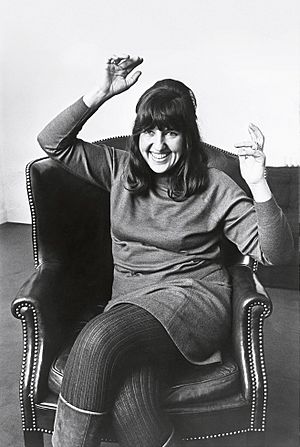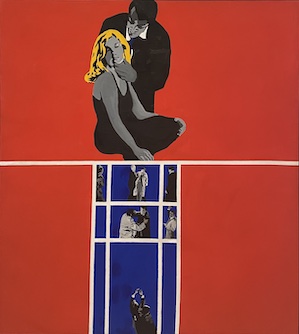Rosalyn Drexler facts for kids
Quick facts for kids
Rosalyn Drexler
|
|
|---|---|

Rosalyn Drexler at her publisher's office
(circa 1960) |
|
| Born |
Rosalyn Bronznick
November 25, 1926 |
| Died | September 3, 2025 (aged 98) New York City, U.S.
|
| Other names | Julia Sorel |
| Known for | Painting |
|
Notable work
|
Marilyn Pursued by Death, 1963 |
| Movement | Pop art |
| Spouse(s) |
Sherman Drexler
(m. 1946; died 2014) |
Rosalyn Drexler (born Bronznick; November 25, 1926 – September 3, 2025) was a talented American artist, writer, and even a professional wrestler! She was known for many things, but especially for her bright and bold Pop art paintings. She also wrote many books, including the novel version of the famous movie Rocky, using the pen name Julia Sorel. Rosalyn Drexler lived and worked in New York City, New York, for most of her life.
Contents
Early Life and Education
Rosalyn Drexler was born in 1926 in the Bronx, New York. She grew up there and in East Harlem. As a child, she loved the performing arts, often going to shows with her family. Her parents also encouraged her interest in art by buying her posters, books, and art supplies.
She attended the High School of Music and Art in New York City, where she focused on singing. After just one semester at Hunter College, she left school. At 19, in 1946, she married the painter Sherman Drexler. She even appeared in many of her husband's paintings.
Professional Wrestling Career
In 1951, Rosalyn Drexler and her husband lived near a gym in Hell's Kitchen, Manhattan. Many female professional wrestlers trained there. A friend suggested she try wrestling, and Rosalyn soon started working out at the gym. She learned how to wrestle safely and how to make her moves look exciting for the audience.
Drexler began traveling for wrestling matches, performing in places like the South and Florida. She wrestled under the name "Rosa Carlo, the Mexican Spitfire." She even wrestled in unusual spots, like a graveyard and an airplane hangar! There's a famous photo of her preparing to fight Mae Young, another well-known wrestler. However, she eventually returned home because she was upset by the racism she saw in the southern states, such as separate seating and water fountains for different groups of people. Later, the famous artist Andy Warhol created a series of silkscreen paintings based on a photo of Drexler as Rosa Carlo.
Her experiences as Rosa Carlo inspired her 1972 novel To Smithereens. She wrote the book because she felt her wrestling journey, though difficult, should be shared. This novel was later made into the 1980 film Below the Belt. When she was 54, she tried a power lifting contest, showing her continued interest in athletics.
Rosalyn Drexler also created several paintings inspired by women's wrestling. These include Take Down (1963), Lost Match (1962), and The Winner (1965).
Writing Career
Rosalyn Drexler was a very busy writer, creating many different types of works.
Novels
- I Am the Beautiful Stranger (1965)
- One or Another (1970)
- To Smithereens (1972)
- The Cosmopolitan Girl (1974)
- Unwed Widow (1975)—written as Julia Sorel
- Starburn: The Story of Jenni Love (1979)
- Bad Guy (1982)
- Art Does (Not!) Exist (1996)
- ... Lives (2007)
Adapted Screenplays
She also adapted screenplays for movies, often using her pen name Julia Sorel:
- Dawn: Portrait of a Teenage Runaway (1976)
- Rocky (1976)—Based on the screenplay by Sylvester Stallone
- Alexander, The Other Side of Dawn (1977)
- See How She Runs (1978)
Plays
Drexler wrote many plays that were performed in theaters across the country and even in London. Some of her well-known plays include Home Movies (1964), The Line of Least Existence (1967), and Fiction (1972). Her plays were shown at famous places like the Judson Memorial Church and the Manhattan Theatre Club.
Television
In 1973, Drexler was one of 15 writers for the CBS comedy special Lily. This show starred famous comedians like Lily Tomlin, Alan Alda, and Richard Pryor.
Career in the Visual Arts
Rosalyn Drexler started her art career by making sculptures from "found objects" (everyday items she discovered). She would build these sculptures using scrap metal and wood, covering them with plaster. These early works were shown alongside her husband's paintings in 1955.
After moving to New York City, she continued to exhibit her art. Critics described her early sculptures as "ridiculous and nutty" but also noted their "real beauty." Her work was shown at the Reuben Gallery in 1960, where she also took part in "Happenings" (art events that combined different art forms). Famous artists like David Smith and Franz Kline praised her work. When the gallery closed, she found it hard to get new offers as a female sculptor. So, she decided to switch to painting to try and get more opportunities. To support herself while making art, she worked various jobs, including being a waitress and a masseuse.

By 1961, Drexler began creating Pop Art. She would look through old magazines, posters, and newspapers for images. Her unique process involved enlarging these images, collaging them onto canvas, and then painting over them with bright, bold colors. She often worked from home, as she didn't have a dedicated art studio.
Drexler had solo shows at the Kornblee Gallery from 1964 to 1966. In January 1964, her art was part of an important exhibition called the "First International Girlie Exhibit" at Pace Gallery in New York. She and Marjorie Strider were the only two women Pop artists in this show, which also featured famous artists like Andy Warhol and Roy Lichtenstein. Her paintings, which often used images from popular magazines, were generally well-received. One critic noted her "virtuosic, uninhibited imagination" in showing different aspects of modern life.
Even though her Pop paintings received good reviews and were shown in major exhibitions throughout the 1960s, Drexler didn't become as famous as many of her male peers. Her paintings often explored challenging topics like difficult relationships, social isolation, and unfair treatment, which were sometimes seen as controversial in the "cool" world of Pop Art. She once said she was happy being productive but later felt angry about not getting enough recognition.
More recently, Drexler's Pop paintings have been recognized as early examples of feminist art, even though she didn't intend them to be political. She also signed a pledge in 1968 to protest the Vietnam War by refusing to pay certain taxes.
In 2018, her work gained new attention with a major exhibition looking back at her career at the Rose Art Museum. In 2022, the Hirshhorn Museum and Sculpture Garden even named an exhibit after her 1963 painting, "Put it this way."
Major Themes and Works
Rosalyn Drexler's art often explored themes from popular culture, especially how women were shown in movies and stories. She used images from public media that everyone could easily understand.
Her The Love and Violence series of paintings showed difficult relationships between men and women. These canvases looked like the covers of old story books or movie posters. Works like I Won't Hurt You (1964) and This is My Wedding (1963) explored challenging situations women faced. Other paintings in this series include The Bite (1963) and Love and Violence (1965).
Is It True What They Say About Dixie? (1966) was inspired by a newspaper photo of a police chief leading a group of white supremacists during the Birmingham race riot of 1963. The painting, with a title from a popular song, commented on the unfair treatment of people based on their race at the time. Similarly, F.B.I. (1964) showed government agents, making viewers think about their role and authority.
The Men and Machines series showed working men with different types of equipment. These paintings reflected the technological advancements of the Cold War era. An example from this series is Pilot to Tower (1966). Marilyn Pursued by Death (1967) shows Marilyn Monroe being followed by a man. While it looks like a stalker, the original photograph shows the man was actually her bodyguard.
Rosalyn Drexler also made paintings based on movie posters. These include King Kong aka The Dream (1963), inspired by the movie Konga, and Chubby Checker (1964), based on the poster for the musical Twist Around the Clock.
Connections with Other Artists
Rosalyn Drexler had many friends who were also artists. She was close with Franz Kline, Bill and Elaine de Kooning. She also knew Eva Hesse, George Segal (for whom she sometimes posed), Lucas Samaras, Claes Oldenburg, Alice Neel, and Joy Harjo. She even worked on plays with John Vaccaro.
Public Collections
Rosalyn Drexler's artwork can be found in many important museums and galleries. Some of these include:
- Hirshhorn Museum and Sculpture Garden, Smithsonian Institution, Washington, D.C.
- Whitney Museum of American Art, New York
- Philadelphia Museum of Art, Philadelphia
- Rose Art Museum, Brandeis University, Waltham, Massachusetts
- Walker Art Center, Minneapolis, Minnesota
Select Awards
Rosalyn Drexler received many awards for her amazing work in art and writing:
- 1964 Obie Award for Distinguished Play, Home Movies
- 1965, 1968, 1974, 1986 Rockefeller Grants in Playwriting
- 1970-71 Guggenheim Fellowship for Fiction
- 1973 Emmy Award for Best Writing for Comedy-Variety (Special Program), Lily
- 1979 Obie Award for Best Playwriting, The Writer's Opera
- 1985 Obie Award for Best Playwriting, Transients Welcome
- 1997-8 Bunting Fellowship at Radcliffe College/Harvard University, Visual Arts-Painting
- 2007 Honorary Degree of Doctor of Fine Arts from the University of the Arts, Philadelphia
Personal Life and Death
Rosalyn Drexler had a son and a daughter with her husband, Sherman Drexler. Her daughter passed away in 2010, and her husband passed away in 2014. Rosalyn Drexler herself passed away in Manhattan, New York City, on September 3, 2025, at the age of 98.

